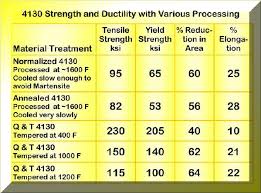Heat Treating 4140 Steel

Heat Treating 4140 Steel
4140 steel is a high-strength alloy that is made up of iron, chromium, silicon and molybdenum. This material has excellent strength for lower weights. Heat treatment is a process of using high temperatures to change the molecular structure of the material in order to harden or soften the material.
Instructions
The Heat Treatment Furnace
Step 1
The process of heat treating is a complicated one if you are hoping to achieve high standards of quality. For the home shop hobbyist, the process is simpler, to an extent. Heat treatment can be split into a number of operations, each which will be separated into a number of steps. The first step is to make a heat treatment furnace.
Step 2
Heat tends to even out. If you try to heat treat steel without something to keep the heat in, it will be very difficult to maintain a temperature, and a lot of the heat will get wasted. That is why we will build a furnace chamber out of bricks. Try and find bricks that are rated for the highest heat resistance. Lay out a layer of bricks flat and even. Try and lay out a size that will hold the largest piece you will heat treat, with two thicknesses of brick on each side.
Step 3
You will now stack a layer of bricks along the perimeter and on top of the bricks you have laid out. Keep the bricks tight together. For now, place bricks only along three sides of the perimeter. Also be sure to alternate the positions of the bricks like a brick wall. Once you have reached the intended height of your chamber, place the steel plate on top of the bricks, making sure it does not project past the sides of the bricks.
Step 4
Now add a second layer of bricks along the outside of the chamber that was built. Place these right up against the first layer, stacking them a layer or two higher than the steel plate.
Step 5
Layer bricks on top of the steel plate, making sure not to leave any portion of the plate exposed.
Step 6
Using the furnace chamber involves placing the steel into the chamber, adding the heat source and in some cases placing bricks over the opening to keep the heat in.
Quenching
Step 1
Quenching is the rapid cooling of the metal. It will impart upon the metal extra hardness, without creating weaknesses or warpage. To begin, place the part into the furnace, putting it onto extra bricks and making sure to have the most air surrounding the piece. You also want to place your container of oil and water on bricks close by.
Step 2
Take your torch or heat source and heat the piece of 4140 steel. You want to try and be as even as possible in heating.
Step 3
Once the piece is hot enough, which can be seen as a bright, yellow glow of the steel, you want to quickly and carefully grab the part and place it quickly into the oil or water. Stand back as hot fluids will be ejected. The choice of water will provide hardness. Oil will add carbon to the steel, making it harder, but also a little brittle.
Tempering
Step 1
Quenching makes steel very hard. It will also make it brittle. To make it less brittle without undoing the hardening, place your part into the furnace chamber just like above.
Step 2
Heat the part like above, but only to about a dull, cherry red glow.
Step 3
Over the next few minutes, slowly turn the heat down, letting the piece cool slowly. The slower you go, the less brittle the piece will be. It will still retain most of its strength, yet be able to withstand forces which may cause it to suddenly chip or break.
Annealing
Step 1
The process of annealing will soften the material. In this state it is easier to cut and machine, shaping it as needed. It begins as above, placing the part into the chamber.
Step 2
Add the heat source and close off the chamber as much as possible. Make sure that you can safely reach the temperature. Heat the part until it reaches the bright yellow glow state. Keep it at that temperature for at least a half-hour. You want to make sure the piece is heated all the way through.
Step 3
Pull out the heat source, turning it off and seal your chamber completely. Make sure that there are no air openings.
Step 4
Let the part cool without opening the chamber. It may take anywhere from six hours to a day. Temperature needs to go down very slowly. Once the piece is at room temperature, it is annealed.
